Introduction to local marketing
Welcome to your Local Marketing 101 course! After you complete this lesson, you should have an understanding of:
- What local marketing is.
- Types of local marketing.
- How local marketing works to grow your business.
- How to set goals for your local marketing.
- What you need in order to make your local marketing strategy a success.
Let’s get learning!
What is local marketing?
Let’s first look at the definition for marketing. According to the American Marketing Association, marketing is:
“the activity, set of institutions, and processes for creating, communicating, delivering, and exchanging offerings that have value for customers, clients, partners, and society at large.”
Now, let’s look at what the Oxford English dictionary says about local:
“belonging or relating to a particular area or neighborhood, typically exclusively so.”
So, if we put that together, the definition for local marketing would be:
“the activity, set of institutions, and processes for creating, communicating, delivering, and exchanging offerings that have value for customers, clients, partners, and society at large in a particular area or neighborhood.”

This is a pretty great depiction of what local marketing is. Essentially, it’s taking your marketing tactics, like Google advertising, social media marketing, and more, and targeting those tactics to a local audience.
Why is local marketing important?
Local marketing is important for a lot of reasons. The first, and most obvious, being that you want to get customers for your business in your area. Why? Because these are the people who are most likely to buy from you or do business with you.
In order to target, engage with, and attract those local customers, you need local marketing and localized marketing strategies.
The second reason local marketing is important is that people are searching for local businesses. Google estimates that 46% of all its searches have local intent, which translates to 1.4 BILLION local searches every day.
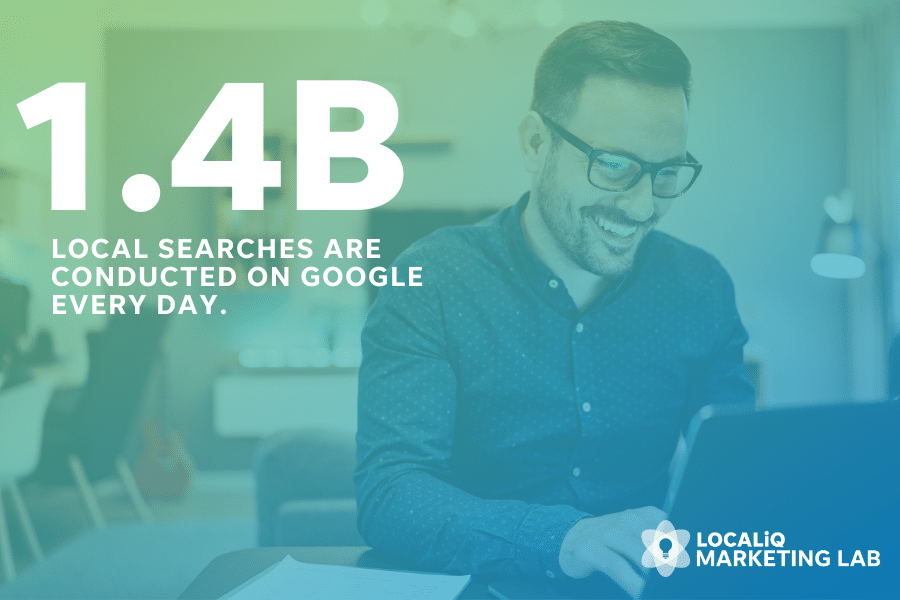
You want your business to appear for the searches with local intent, because, again, those searchers are your most likely customers.
Without localized marketing strategies, you might be missing out on getting in front of buyers searching for your products or services right in your area.
13 major types of local marketing
Now that we’ve talked about what local marketing is and why you need it, let’s talk about the different types of local marketing. I’ll warn you: there are a lot. But, it’s important to understand each type in order to create a localized marketing strategy that works for your business.
First, a preview of the types of local marketing you might encounter:
- Local SEO
- Local PPC
- Your Website
- Social Media Marketing
- Local Facebook Advertising
- Local Listings
- Local Display Advertising
- Local Branded Content
- Local Print Advertising
- Targeted Email Marketing
- Direct Mail
- Local Sponsorships & Event Marketing
- Local Video Advertising
It’s just 13 – it could be more, right? Now that you have a preview, let’s dive into how local marketing can help you grow your small business and the types of local marketing to consider.
How to use local marketing to grow your small business
Local marketing encompasses many different strategies and tactics meant to help you grow awareness for your small business, get new customers, engage with existing customers, and build your brand.
The best local marketing strategies include multiple local marketing tactics, or types, to work together toward these goals.

Let’s touch on each local marketing tactic and briefly cover how they can help grow your small business.
1. Local SEO
You’ve probably heard of SEO, or search engine optimization, already, but here’s a quick refresher: SEO is a marketing strategy that helps your website show up on the search engine results page (SERP) for searches relevant to your business and your offerings. Basically, it’s how you show up on Google or Bing in the organic search results.
SEO includes optimizing your website both in the backend and in your content for specific keywords and topics your most likely consumer would search for you with. It also has to do with your site structure, load time, and mobile friendliness.
Local SEO includes optimizing your content for local search intent and takes into account offsite factors like your local listings to help you improve visibility on search engines, review sites, and local listings, like on Google Maps.

Remember, we said that 46% of all searches have local intent, so local SEO is a must-have strategy.
2. Local PPC
Paid search advertising, also known as search engine marketing (SEM) or pay per click (PPC) advertising, is a marketing strategy that allows you to run ads on top search engines like Google or Bing.
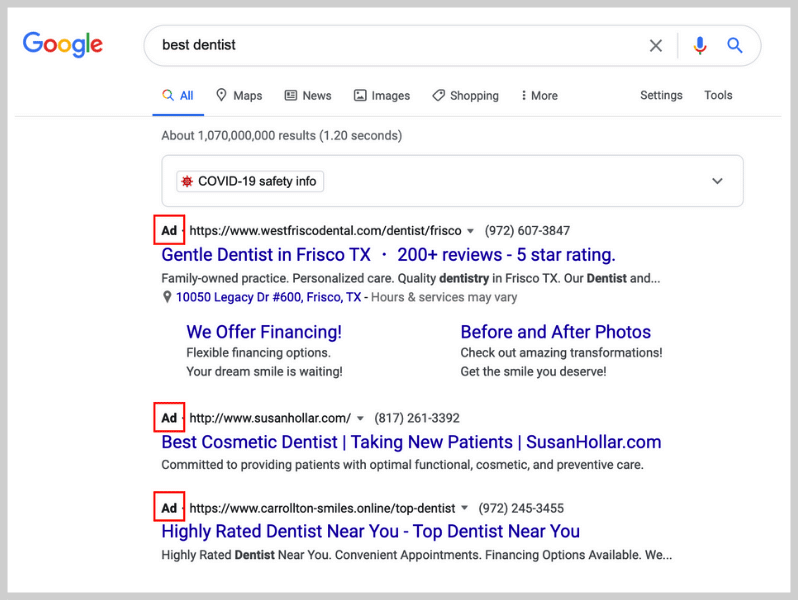
With paid search advertising, you only pay for clicks on your ad rather than impressions (or how many times a searcher sees your ad without clicking on it).
PPC ads show on the top of search results but can also appear on the side panel in desktop search results and in maps.
PPC ads provide a valuable way for your business to get in front of interested searchers and build awareness for your brand.
When you run PPC ads, you have an opportunity to localize your strategy in a few different ways. Obviously, as with any ads, there are geotargeting options available so your ads are only shown to searchers within a specific area.
You can also run local PPC ads by incorporating local keywords into your bidding strategy and by enabling location extensions in Google Ads. Location extensions are used in local PPC to drive customers to your business and show up in search results and Google Maps, and can also appear in the Google Display Network and in YouTube video ads.
3. Localizing your website
Every business needs a website, especially for local marketing. Your website is the hub for your business – the place all your other marketing strategies should be driving traffic and interest to. It also serves as its own powerful local marketing tool.
Your website includes your contact information, including your address, which makes it a localized marketing tactic.
And, by creating local keyword-rich content, you can localize your website and increase your chances of appearing in local search results.
We’ll talk more about the importance of your website when it comes to local marketing later (or you can skip there now).
4. Social media marketing
Social media marketing, which includes having a presence for your business on social sites like Facebook, Instagram, Twitter, and LinkedIn (if it makes sense for your business), is another local marketing strategy that’s important to consider.

Your Facebook and Instagram profiles allow you to include business information like your address, and you can add a location to your pictures and posts, allowing you to get found by potential customers in your area.
On Facebook, Instagram, Twitter, and LinkedIn, you can also use location-specific hashtags to help local users find your page.
5. Local Facebook (and Instagram) advertising
Facebook advertising allows you to target users on both Facebook and Instagram with ads about your business to expand your reach and get more customers – at least, that’s the goal!

Facebook has powerful targeting capabilities so you can serve your ads only to users in a specific location, increasing the chance that they’ll do business with you.
With local Facebook advertising, you can get pretty granular, which works in your favor if there’s a specific ZIP code you want to target within your community – or you can leave it more open and target your whole town or city.
6. Local listings
Business listings, like Google My Business and Yelp, allow searchers to find information about your business in SERPs but also in apps on their phones. Listings are local in nature – each listing is built around your basic business information like your business name, address, phone number, and website.
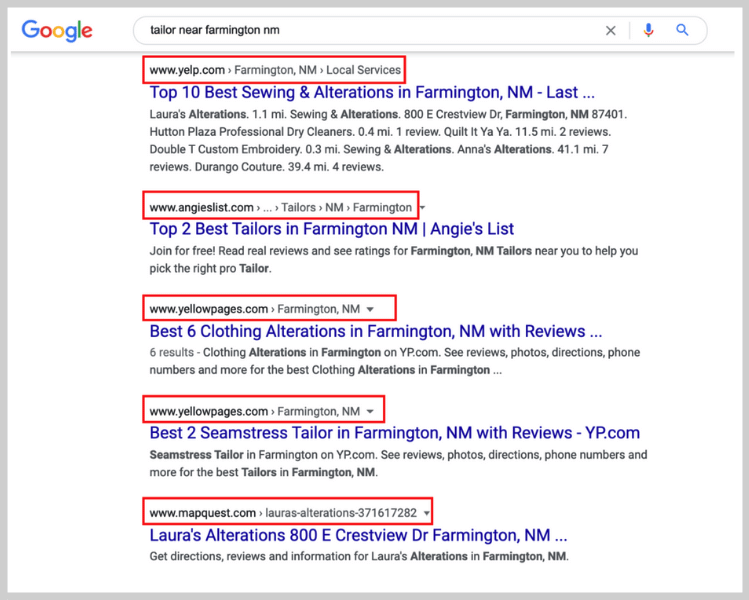
People use the information on local listings to find out where businesses are located, read reviews, or contact the business directly. I personally do all my searching for new businesses on my Google Maps app so I can get an easy snapshot of a business and see how close they are to me.
If your local listings are inaccurate, you could miss out on shoppers ready to buy from your business, and it could impact your local SEO. Google and other search engines use the information from local listings – again, your business name, address, and phone number (also known as NAP) – to determine how trustworthy information is about your business online.
If search engines see different variations of your business name, different phone numbers listed, or different addresses, you could get shown lower in search results for relevant local searches.
7. Local display advertising
Display advertising involves placing visual ads on sites across the web. For example, you can run a display ad on a local news site, like the Indy Star as pictured below, to get in front of local buyers.

Display ads are a great local marketing tactic because you can target local sites and local customers with your display advertising targeting.
Display ad retargeting allows you to further target local customers who have visited your site without converting (submitting a form, making a purchase, calling your business, etc.). Once they leave your site, they see display ads from your business with the goal of bringing them back to your website and becoming a lead or customer.
Geofencing is another display advertising tactic. With geofencing, you draw a virtual fence around a specific area using GPS technology. Once a person enters that area with their smartphone, you can show them ads in the form of offers or promotions to encourage them to visit your business.
Pro Tip: Use geofencing to target customers at your competitor’s location to lure them away from your competitor and to your business with an enticing offer.
8. Local branded content
Branded content is content that is essentially sponsored by a business and placed on a third-party site. Branded content can take many forms, including articles, infographics, quizzes, videos, and more. The purpose of branded content is to increase brand awareness, educate or inform the public, and promote the trustworthiness of your business.
For example, if you own a plumbing business, you can run a branded content series on your local news site about keeping your home safe from plumbing disasters during the holidays. The content isn’t meant to sell – simply to inform – but when it comes time for someone to find a plumber for their emergency, why wouldn’t they choose the business that’s been providing such helpful information?
Branded content is an effective part of a localized marketing strategy because you can target local customers through your local news sites – increasing the chances of getting in front of people who are most likely to do business with you in your area.
9. Local print advertising
Print advertising is exactly what it sounds like – running ads in the newspaper. You can’t get much more local than placing ads in your local paper.
Over the years, many businesses have made a transition away from print advertising – instead focusing on digital marketing strategies. While digital marketing is essential to reach people spending time online – print advertising is still an important local marketing strategy.
And, did you know print advertising is actually the most trusted form of advertising? Eighty-two percent of consumers report they trust print ads.

Print advertising can work in tandem with your local digital marketing efforts. One study found that print ads make digital marketing four times more effective!
10. Targeted email marketing
Email marketing involves sending marketing emails to a list. If you take it a step further, you get targeted email marketing – which are marketing emails that speak to a subset of that list, allowing you to better personalize your messages and offers.
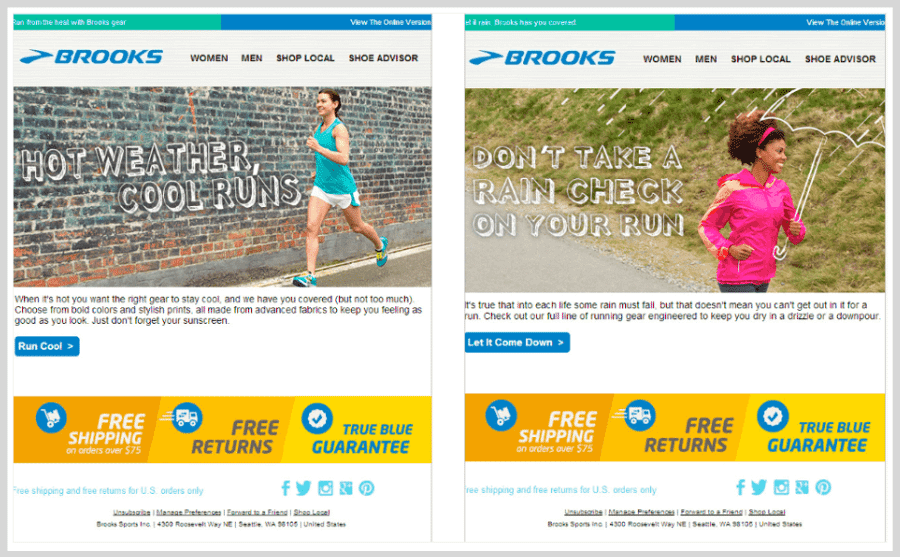
With targeted email marketing, you can send your emails to people within a specific location, allowing you to use location-specific images, verbiage, and more to better personalize your email marketing campaigns.
This local marketing strategy is a great way to build brand awareness, keep in contact with people who might not be your customers yet, and provide offers to entice people to do business with you.
11. Direct mail
Direct mail is a form of direct marketing that involves sending mail to people in a specific area. You’ve probably received this type of marketing at your own home in the form of coupons, new business openings, and restaurant menus.
You can send direct mail to certain ZIP codes, making it an excellent local marketing strategy. It’s also fairly cost-effective, easy to track with the use of coupon codes, tracking URLs, and tracking phone numbers, and can help boost awareness for your business.
12. Local sponsorships and event marketing
Sponsoring or hosting events is a tried-and-true local marketing strategy that allows you to connect with your community while giving back.
Local sponsorships are just what they sound like: an opportunity for your business to sponsor local events or organizations. You can sponsor charitable events like charity runs or larger community events like food and wine festivals.

When you sponsor or host an event, you can get your business in front of local customers, increase awareness for your business, and build a positive brand association, which can lead to getting more customers for your business.
13. Local video advertising
Did you know that YouTube is the second-largest search engine in the world – after Google (which, consequently, owns YouTube)?
When you run YouTube advertising, you can choose the target audience for your ads. When you define your audience by geographic location, you can run local video advertising that gets you in front of local buyers when they’re consuming content on YouTube.
Local YouTube advertising is a great localized marketing strategy because it can help you build awareness with local consumers, drive traffic to your website or a specific landing page, and engage with customers in a format they enjoy.

You made it!
Alright, we’ve made it through the top 13 local marketing strategies that can help your business get local customers, build brand awareness in your community, and engage with a local audience. Now let’s talk about the different goals you can define for your local marketing strategy.
Goals for your local marketing strategy
Before you get started with local marketing, you need to set some goals. As Tony Robbins said, “Setting goals is the first step in turning the invisible into the visible.”

Of course, it’s not just about making marketing goals you’ll never meet. You have to eventually walk the walk.
The process of setting goals, however, puts you in the right state of mind for accomplishing work and seeing positive results. Local marketing goals, properly planned and executed, are the steppingstones to growing your business.
The benefit of setting local marketing goals
Why do you need to set local marketing goals? You need a way to gauge your local marketing efforts. Otherwise, how will you know if what you’re doing is working, or if it’s simply luck? Local marketing goals enable you to stay on track with the objectives for your small business.
Setting quantifiable goals allows you to properly allocate time and money to local marketing strategies that work, and to do away with those that don’t. Some quantifiable marketing goal examples are follower counts, ROI, weekly or monthly sales, site visits, and other “countable” items.
Short-term goals for local marketing
Short-term local marketing goals are, as the name implies, goals that can be completed within days or weeks. Long-term goals can take several months, or even several years, to meet. While long-term goals are key to establishing your ultimate vision, and while they guide the direction of your short-term goals, they’re not as actionable as short-term goals.
Short-term business and local marketing goals are things you’re going to be focusing on on a daily basis. Without them, your long-term goals, all those grand “big fish,” will never see the light of day.

Here are some examples of short-term business goals as they relate to local marketing:
1. Increase website traffic
Your website is the foundation for your local marketing. More website traffic tends to lead to more customers, and if you’re running local marketing, that means those customers will be local. Try to set weekly or monthly goals, such as a 5% increase in website traffic each month.
2. Increase conversions
In marketing, conversions are defined as the act of converting site visitors into paying customers. Conversion marketing incorporates a variety of techniques to lower the barriers of entry to purchase and encourage site visitors to buy a product.
For example, a company might offer new site visitors 20% off their first purchase in order to encourage them to place an order right away with the goal of increasing conversions by a certain percent.
3. Increase follower counts
If you’re running any form of social media marketing or advertising, increasing the follower counts on your social media sites is a good short-term goal. The more followers you have on Facebook, the more people can see your posts and engage with them. Set reasonable markers weekly or monthly to make social media work for your small business and build a loyal following of local customers.
Long-term local marketing goals
Long-term local marketing goals take longer to acquire and are not necessarily as quantifiable as short-term goals. They often start as seemingly impossible to attain but over time, and with hard work, long-term business goals become easier to reach.

The secret to business success is reaching long-term goals through consistent local marketing, something that many business owners struggle with.
Some examples of long-term local marketing goals include:
1. Name recognition
As consumers, we’re more likely to trust the names of companies that we know or have heard of. Getting your business name recognized in your local market will help you get more customers and grow your business.
Make getting your name recognized in your local market a long-term goal of your business. Get involved in local events, post on forums and Facebook groups, and conscientiously network in order to create a buzz about your business in your community.
2. Increased brand awareness
As your business grows and more people become aware of it, you’ll naturally begin to pick up more brand awareness and exposure in the appropriate places. Make brand awareness a long-term goal, whether it’s being featured in the local news, authoring branded content articles, or winning a “best of” title in your local market.

3. Improved brand reputation
A business’s reputation builds over time and is extremely important when it comes to getting more local customers. Because people rely so much on reviews, ratings, and brand perception, you want to make a stellar brand reputation a long-term goal for your local marketing.
You can work toward this goal in your local marketing by maintaining accurate local listings, responding to reviews, and getting new reviews for your business.
4. Better local search ranking
For small businesses, setting goals related to your local search presence is a must. You want your business to appear in local search results for queries related to your products or services. If your long-term goal is to appear at the top of local map results, some short-term goals may be to collect one Google review per week or to optimize your Google My Business profile in one month.
Improving your organic ranking can take a lot of time and effort, but it’s worth it in the long run when you see that increase in organic traffic and leads.
So, now you have an idea of local marketing goals for your small business, and you’re ready to get started, right? Keep reading for tools to make your local marketing a success.
Tools for local marketing success
You’ve got your goals set, you know how local marketing can help you grow your business, and it’s time to get started, right?
Not so fast!
Before you can get started with local marketing, there are a few things you need to have in place, like:
- A website.
- A way to track marketing success.
- A way to manage leads.
- A budget.
- The right strategy.
- The right partner.
We’ll cover each in detail for you.
Is your website ready?
We’ve said it before, but it’s worth repeating: Your website is the foundation of any local marketing strategy.
Why?
Here are five reasons your business needs a website for successful local marketing.

1. Your website is how you distinguish yourself
Social media profiles and listings are informative, but you can’t fully brand your content on these sites, nor do you have control over how — or sometimes what — information is displayed. Your website, however, contains all of the colors and images that fully express your brand, and you can display your information in the most impactful way possible.
With full control over how you tell your story, you can distinguish your business from competitors.
2. Your other marketing strategies depend on your website
Second, your other marketing strategies depend on your website. For example, let’s say you want to run a local PPC ad for a new service. Without a website, there’s nowhere for you to send people who click on your ad! Or maybe you want to generate leads with a promotion code.
You’ll need to provide your audience with a form where they can give their contact information in exchange for the promo code. But without a website, where will that form live?
3. Your website is how you obtain leads and customers
With a proper local marketing strategy, everything should lead customers back to your website — whether that’s your ads, social media posts, emails, or local listings.
Here’s why: Driving traffic to a centralized location allows you to create a sales funnel where prospects can become customers. This is the most important aspect of your website, but we won’t get into it here because we’ve devoted the entire next reason to it.
4. Your website allows you to continuously optimize your strategy
Driving your traffic to one place also allows you to gather insights about your audience to always be improving the effectiveness of your marketing tactics. Website analytics will show you which channels are generating the most traffic, which pages are drumming up the most engagement, and even provide demographic information about your visitors.
This data equips you to further understand your target audience and identify what local marketing strategies are working and which ones aren’t. As you know, local business owners are especially strapped for resources, so being able to weed out any efforts that aren’t yielding results is essential. Having everything lead back to your website affords you that cross-channel visibility.
5. Your website puts you in the driver’s seat of your customers’ journey
The final reason a website is so important is that it puts you in the driver’s seat on the customer journey. Consumers don’t want to be told what to do, but they also don’t want to have to figure out what to do on their own.
A well-designed website provides them with that clear path of action, resulting in a win-win: they willingly and confidently make the journey from discovery to purchase, and you gain more business.
Now you know why a website is so important for local marketing. When set up properly, it can be marketing and growing your business around the clock, even while you sleep!
Do you have a way to track your marketing?
We covered setting goals, but in order to know whether or not you’re reaching those goals, you need a way to track your local marketing.

Luckily, there are a lot of tools out there that can help, like:
Google Analytics
You can connect your website to Google Analytics to track a ton of info like website traffic, time on site, information on who’s visiting your site, and so much more.
UTMs
UTMs are tracking URLs that allow you to see how users are getting to your website. You can create UTMs to show you where someone clicked on your link.
The below example UTM would show that someone clicked on this blog link from Facebook.

You can tie UTMs to Google Analytics and track them as campaigns.
Call tracking technology
With call tracking technology, each channel for your local marketing is assigned a different number (don’t worry, it routes to your main number!). This rolls into a report that shows the source for each call you’ve received, allowing you to understand which local marketing strategies are working to drive the most leads.
Manual tracking
While it’s not the most tech or time-friendly way to track your marketing, you can also ask to keep track of how your customers say they found you or heard of you from them directly.
This might be a section on a new patient intake form listing all the possible places they might have seen information about your business, or an email you send asking customers to let you know how they heard about your business.
How will you manage leads?
Let’s face it: You’re not running local marketing just for fun – you’re running it to get more customers! So, you’ll want a way to track the customers coming in from your marketing.
Here are a few ways to manage your leads.
Use a lead management system
With a lead management system, your leads are automatically funneled into a CRM or customer relationship management system. A CRM collects a lead’s contact information and allows you to add details to their record, assign the lead to people on your team, and mark whether or not you’ve followed up with them.
Many lead management systems also show you where that lead came from, connecting your marketing tracking and your lead management in one place.

A lead management system is going to be the most streamlined and, let’s just say it, easiest, way to keep track of leads from your local marketing.
Keep a manual list
If you’re not ready for a lead management system, you can establish a manual process for managing leads. Many small business owners use a spreadsheet where they’ll keep a list of customer names, email addresses, and notes that everyone in the team has access to. When a new call, email, or website chat comes in, someone is responsible for adding the contact information to the lead list.
Establish a process for following up with leads
Whether you use a CRM to manage leads or a spreadsheet, you’ll want to make sure your business has a process for following up with and engaging with leads.

This might mean you need to train a few members of your team to be your designated leaders on leads so you always know who will be following up.
You’ll probably also want to follow up with leads quickly, so it’s important to establish a timeframe for following up with any new lead that comes your way.
Creating a formal process to manage leads will help streamline the process and give you the best chance of converting those leads into customers.
In order to make your local marketing as successful as possible, you want to make sure you have a place to keep track of new leads, a way to follow up with them, and a process in place for your team to make sure those hard-earned local customers aren’t getting left behind.
What’s your local marketing budget?
Before you can determine your perfect local marketing strategy, you need to know how much budget you have to spend so it can be allocated correctly.
A lot of local marketing strategies, especially the ones that will allow you to get in front of customers and generate leads quickly, require a budget. And, even a few of the unpaid local marketing strategies require some kind of spend (your website isn’t free, after all).
Many local businesses spend 5-10% of their revenue on marketing, and if you’re looking to grow at a faster rate, that percentage will probably need to be closer to 10% or higher.
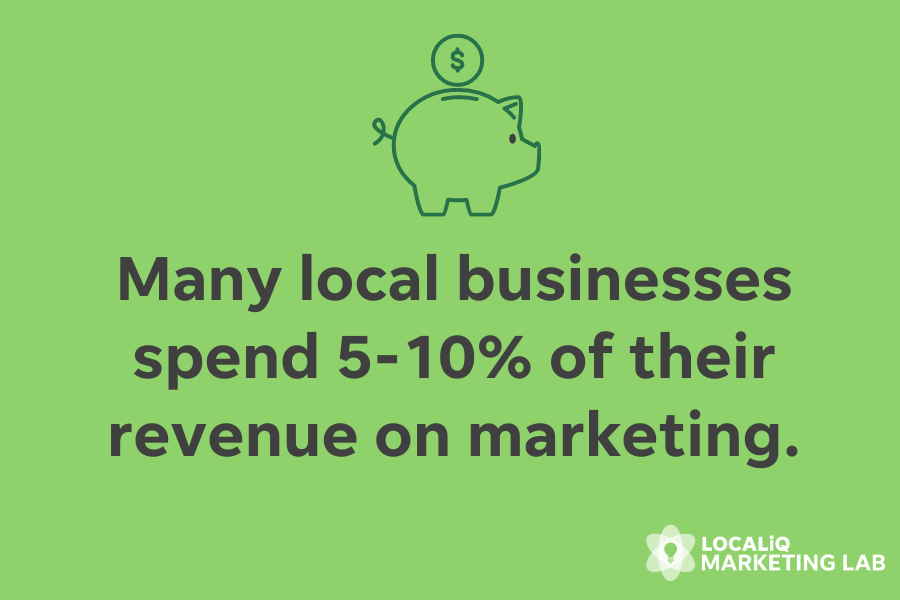
Here are some tips on how to create your local marketing budget:
Organize your financial information
The first step in creating a marketing budget is to organize all your finances. You need to know what you’re working with before you can budget. Gather all your revenue information and business budget details together in one place before you begin. When budgeting, you should base your calculations on “reliable revenue” — the minimum amount of money your company makes each month.
Factor in the costs of the basics
If you don’t already have a website, a way to track your marketing, and a way to manage leads, you’ll need to factor in those costs as they’re essential to the success of any local marketing strategy you run. Once you’ve deducted those costs, you can look at the remaining budget for your marketing strategy.
Determine how you want to create your budget
There are two different options here: You can either create your marketing budget based on a percentage of monthly revenue or based on your goals.

To create a budget based on your monthly revenue, you might adhere to the average 5-10% many local businesses use, so 5-10% of your monthly revenue would go toward marketing. If you’re opening a new business or marketing a newer business, you may need to create your marketing budget based on sales projections.
To create a budget based on your marketing goals, you’ll need to define your business’s long-term goals and then break them into smaller, short-term goals that are quantifiable. For example, if your goal is to increase revenue by $50,000 this year, you might need 1,200 new customers by the end of the year, or 120 each month. How much will it cost to obtain these new customers?
Decide how you’re going to run your marketing
Another factor to consider when determining your local marketing budget is whether or not you’ll be running marketing yourself, hiring someone in-house, or working with a marketing agency. There are costs associated with each. If you’re running the marketing yourself, the main cost will be time. Running local marketing strategies is time-consuming and requires expertise that you may or may not have.
Hiring someone in-house requires its own budget. You’ll need the cost to hire the employee plus whatever budget they need to run your marketing.
If you work with a local internet marketing company, you’ll have to factor in the cost of outsourcing but won’t have to worry about paying onboarding costs or for benefits, and equipment.
Want to know more about working with a marketing partner for your local marketing? We’ll cover that a little later.
What is your local marketing strategy?
Now that you know how much you can spend on your local marketing, it’s time to determine the right marketing plan for your business.

Based on your local marketing goals, you’ll want to run specific types of local marketing to help you reach them.
Here are some things to keep in mind.
Don’t ignore the power of building your brand
When it comes to local marketing, there are certain strategies that are great at directly contributing to getting you new customers. PPC and Facebook ads are oriented around getting people to take an action – and that action is usually to learn more about or contact your business.
But, you can’t ignore the power of other local marketing tactics, like local display advertising, local branded content, and local social media marketing when it comes to building your brand and awareness for your business.
I’m pretty sure we covered that a person needs to see information about a brand 7-10 times before deciding to do business with them, and these brand-building local marketing strategies are going to help you get to that number.
You have to spend money to make money
While there are a number of organic (read: free) local marketing strategies you can use to promote your business and build awareness for your brand, many of them aren’t as effective without their paid components.
For example, organic social media marketing – posting and engaging on Facebook and Instagram – will help you build an audience over time, but Facebook advertising will allow you to grow that audience quicker and reach specific local marketing goals.
A multichannel marketing approach is best
Because people are searching for local businesses in a lot of different ways–search engines, map apps, social media sites, etc.–and seeing information about local businesses in those different places and much more, the best approach for marketing your small business is a multichannel one.

Multichannel marketing means running different types of local marketing so you can ensure your business is reaching customers no matter where they’re looking or spending time both online and offline.
But, once you understand that you need to run your local marketing on different channels, how do you determine the right channels and types of local marketing to focus on? That’s where a local internet marketing company comes in.
Let’s explore that a little more.
Will you work with a local marketing partner?
One study found that 97% of small businesses run some form of DIY marketing – meaning they’re running their marketing themselves.
While this may sound like a good option – more control and less money to outsource or hire someone – in the long run, it can cost you more than just your time.
Here are some reasons you might consider working with a local marketing company.
A local marketing company has local marketing experts
Just like you’re an expert when it comes to your business, a local marketing agency is going to have people who are experts in local marketing. They’ll be keeping up with the latest algorithm changes, critical marketing updates, and best practices while you focus on making sure your business is delivering great customer service and following up with all those leads your local marketing will drive.
A local marketing company can determine your strategy
And, because your local marketing partner has expertise in local marketing, they’ll know what strategy is best for your business – for your budget and your goals. They can determine the right channels to reach new customers, the best ways to engage with customers, and implement it all for you – so you don’t have to worry about learning how to do everything yourself.

A local marketing company can track your marketing
You know those tools we talked about earlier for tracking your marketing? When you work with a local marketing partner, they can take care of that for you – distilling all the data across all the various local marketing sources into one report so you can understand how your marketing is working to get results.
A local marketing company can optimize your marketing
When you run local marketing, there are opportunities for optimizing your strategy and your campaigns. If you run your local marketing yourself, you would have to analyze the data, beef up on best practices, and make manual updates and optimizations.
But, if you work with a local internet marketing company, they can do that for you. And, some local marketing companies have technology that allows them to make those optimizations automatically so you can feel confident that your local marketing campaigns are always working to get you the best results.
A local marketing company can save you time
When it comes down to it: time is money. You don’t want to spend your precious time running your small business’s local marketing when you could be focusing on your customers – or spending time with your family. Partnering with a local marketing company enables you to get one thing off your plate and focus your energy on running your business.
Congratulations, local marketing expert!
You made it to the end of our local marketing course, good for you! Do you feel like you learned something? I hope so.
Check out one of our next courses to keep the learning going:
